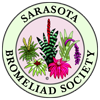Bromeliads are members of the family Bromeliaceae, which contains such diverse plants as Spanish moss (Tillandsia usneoides) and pineapple (Ananas comosus). Many are epiphytes.
Many bromeliads have been brought into cultivation as ornamentals, some because of their spectacularly colored and long lasting inflorescences (flower shoots), and others because of their colorfully patterned leaves. Most bromeliads can be easily recognized by their overlapping rosette of leaves which retain water' hence they are commonly called "vase plants." The pool of water that collects in the tank is home to many organisms, including frogs, lizards and insect larvae.
Approximately 2,500 species are known, with new discoveries added to their ranks every year. They are found almost exclusively in the American tropics and subtropics and are frequently the most conspicuous epiphytes in the forest in which they occur.
From: Selby Botanical Gardens
Is it safe to grow bromeliads? The Florida Council of Bromeliad Societies says "Yes, bromeliads are safe to grow!". You can read the Council's full report about bromeliads and mosquito bourne illnesses here:
Compiled by Dr. Dale W. Jenkins
Originally published in the Sarasota Bromeliad Society newsletter, December 1998.
Published here as downloadable and printable PDF – 9 pages, 103k.
H. E. Luther, Director, Mulford B. Foster Bromeliad Identification Center
Marie Selby Botanical Gardens
 |
 |
 |
 |
 |
 |
 |
 |
 |
 |
 |
 |
 |
 |
 |
 |
 |
View Planting Guide Here. |
A downloadable and printable version of this guide is available here – 3pages, 255k.
The bromeliad family (Bromeliaceae) consists of 51 genera and about 1,500 strictly American species. They grow from the dry deserts of southwestern United States to equatorial tropical rain forests. Based on growth habits and other characteristics, Bromeliaceae is divided into the subfamilies Pitcairnioideae, Tillandsioideae and Bromelioideae.
Members of the subfamily Pitcairnioideae are mainly terrestrial plants with heavy spines on their leaf edges. They grow in soil or on rocks and do not have a leaf rosette that traps water. The genera belonging to this subfamily commonly cultivated are Dyckia, Hechtia, Pitcirnia and Puya.
The subfamily Tillandsioideae contains the least number of genera but the largest number of species, of which many are cultivated. Plants in this group have smooth or entire leaf margins, unusual foliage markings and colors. Some species produce fragrant flowers. Plants in the genera Guzmania, Tillandsia and Vriesea are the more commonly cultivated members of this subfamily.
Bromelioideae, the third subfamily, has the most bromeliad genera grown as garden and interior plants. It encompasses 30 genera with the widest range of plant forms, and accordingly the largest number of cultivated species. Subfamily members are mostly epiphytic, leaf edges are almost all spiny, foliage has attractive markings and patterns, and the leaves are usually arranged in rosettes which may be cup-shaped. Aechmea, Billbergia, Cryptanthus, Neoregelia and Nidularium are the most popular genera of this subfamily.
Overview by: www.Bromeliads.Info


